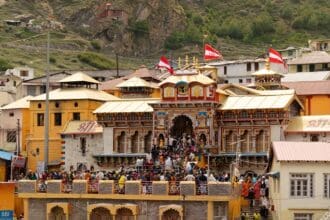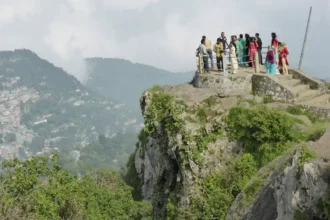Nestled in the foothills of the Himalayas, Dehradun is a city that beautifully blends modernity with natural splendor and historical significance. As the capital city of Uttarakhand, Dehradun has evolved into a dynamic hub that caters to nature lovers, history buffs, adventurers, and spiritual seekers alike. From its breathtaking landscapes and ancient temples to its elite educational institutions and adventurous escapes, Dehradun offers a myriad of experiences for everyone.
In this detailed exploration, we will uncover Dehradun’s geography, climate, history, key attractions, educational significance, local culture, and much more, showcasing why this city remains a must-visit destination for travelers worldwide.
Geography and Climate – The Natural Bounty of Dehradun
Dehradun sits gracefully in the Doon Valley, flanked by the Himalayan ranges to the north and the Shivalik hills to the south. Its location between two of India’s most sacred rivers—the Ganges and the Yamuna—adds to the city’s spiritual and geographical significance. This unique placement makes Dehradun a picturesque destination with diverse terrain, from lush green valleys to rugged hills.
Geographical Features
- Altitude: Situated at an elevation of approximately 447 meters (1,467 feet), Dehradun offers visitors breathtaking vistas and a climate that is both refreshing and rejuvenating.
- Water Sources: Rivers such as the Rispana, Bindal, and Tons crisscross the region, contributing to its lush greenery and rich biodiversity.
- Neighboring Towns: Dehradun serves as the gateway to popular hill stations like Mussoorie (35 km away) and Dhanaulti, as well as pilgrimage destinations such as Haridwar and Rishikesh.
Climate Overview
Dehradun’s climate is a significant draw for tourists, as it offers pleasant weather year-round.
- Summers: The temperature ranges from 17°C to 35°C, with cool mornings and evenings perfect for sightseeing.
- Monsoons: From July to September, the region experiences moderate to heavy rainfall, which enhances its natural beauty but can also cause occasional landslides in surrounding areas.
- Winters: Winters are chilly yet enjoyable, with temperatures dropping as low as 3°C. Snowfall is rare in Dehradun but common in nearby hill stations.
Historical Significance – The Rich Tapestry of Dehradun’s Past
Dehradun has a history steeped in mythology, spirituality, and colonial heritage. The city’s origins date back to ancient times, with mentions in texts from the Mahabharata era. Over the centuries, it has been shaped by diverse cultures, empires, and influences, each leaving an indelible mark on its identity.
Mythological Connections
- According to Hindu mythology, Dehradun is believed to have been visited by the Pandavas during their exile, making it a place of significant spiritual importance.
- The name “Dehradun” is derived from ‘Dera’ (meaning camp) and ‘Dun’ (meaning valley). It is said that Guru Ram Rai, the son of the Sikh Guru Har Rai, established his camp here in the 17th century, giving the city its name.
Influence of Empires
- Mauryan and Gupta Periods: Dehradun thrived during these ancient empires, becoming a key center for trade, learning, and culture.
- Mughal Era: The city witnessed flourishing art and architecture under Mughal influence.
- British Rule: Under British rule, Dehradun gained prominence as an administrative hub. The British built schools, churches, and colonial-style bungalows, many of which remain landmarks today.
Tourist Attractions in Dehradun – A Treasure Trove of Experiences
Dehradun is home to a diverse range of attractions that cater to various interests. Whether you’re drawn to its natural wonders, spiritual sites, or historical landmarks, the city offers a unique experience for every traveler.
1. Robber’s Cave (Gucchu Pani)
Robber’s Cave is a natural cave formation known for its flowing streams and unique phenomenon where water seemingly disappears underground. This spot is perfect for adventure enthusiasts and families alike. Visitors can walk through knee-deep water surrounded by cliffs, making it an unforgettable experience.
2. Sahastradhara
Literally translating to “Thousandfold Spring,” Sahastradhara is renowned for its sulfur-rich waters, believed to have therapeutic properties. The cascading waterfalls and serene surroundings make it an ideal spot for relaxation and photography.
3. Forest Research Institute (FRI)
The Forest Research Institute, a masterpiece of Greco-Roman architecture, is a prominent landmark in Dehradun. Spread over 450 hectares, its lush campus houses several museums dedicated to forestry, wildlife, and ecology, making it a haven for history and nature enthusiasts.
4. Tapkeshwar Temple
Dedicated to Lord Shiva, the Tapkeshwar Temple is located within a cave where water naturally drips onto the Shiva Linga. This sacred site draws pilgrims and tourists who seek spiritual solace amidst its serene surroundings.
5. Mindrolling Monastery
One of India’s largest Buddhist monasteries, the Mindrolling Monastery is a center for spiritual learning and Tibetan art. Its beautifully landscaped gardens, massive stupa, and intricate murals attract visitors seeking peace and cultural enrichment.
6. Clock Tower (Ghanta Ghar)
The Clock Tower is an iconic historical landmark located in the heart of the city. Surrounded by bustling markets, it’s the perfect spot to soak in the city’s vibrant atmosphere and indulge in shopping for local crafts and delicacies.
7. Malsi Deer Park
This zoological park, located on the outskirts of Dehradun, is a great spot for families and nature lovers. It offers a chance to observe deer, peacocks, and other wildlife in a well-maintained environment.
Educational Capital of India – Dehradun’s Renowned Institutions
Dehradun is often referred to as the “School Capital of India” due to its prestigious educational institutions that have shaped generations of leaders, scholars, and professionals.
Prominent Schools
- The Doon School: Established in 1935, this elite boarding school is renowned for its academic rigor and holistic approach to education.
- Welham Boys’ and Girls’ Schools: These institutions have earned a reputation for excellence in education and character building.
Higher Education and Research
- Indian Military Academy (IMA): A premier institution for training officers of the Indian Army.
- Wadia Institute of Himalayan Geology: A leading center for research on Himalayan geology and seismology.
- University of Petroleum and Energy Studies (UPES): Known for its specialized programs in engineering, energy, and law.
Local Cuisine and Shopping – A Cultural Delight
Dehradun offers a vibrant shopping experience and a chance to savor the flavors of Garhwali cuisine.
Shopping Destinations
- Paltan Bazaar: Known for traditional handicrafts, woolens, and spices.
- Tibetan Market: A hub for Tibetan handicrafts, jewelry, and souvenirs.
Must-Try Dishes
- Aloo ke Gutke: A spicy and flavorful potato dish.
- Bal Mithai: A signature sweet made of roasted khoya and sugar.
- Singodi: A dessert served in leaf cones, showcasing the region’s traditional culinary practices.
Adventure Activities – Thrills in the Valley
Dehradun is an adventurer’s paradise, offering a variety of outdoor activities such as:
- Trekking to nearby hill stations and valleys.
- River Rafting in the Yamuna and Tons rivers.
- Paragliding over the scenic Doon Valley.
- Exploring the Rajaji National Park, home to elephants, leopards, and tigers.
Conclusion
Dehradun is a city that perfectly encapsulates the beauty, history, and culture of Uttarakhand. Its unique blend of natural wonders, spiritual landmarks, educational excellence, and modern amenities makes it a destination worth exploring. Whether you’re planning a short getaway or a long vacation, Dehradun has something special for everyone.
FAQs About Dehradun – The Capital City
1. What is Dehradun famous for?
Dehradun is famous for its picturesque landscapes, prestigious educational institutions, spiritual sites like Tapkeshwar Temple, and attractions like Robber’s Cave and Sahastradhara.
2. What is the best time to visit Dehradun?
The best time to visit Dehradun is during the summer months (March to June) when the weather is pleasant. Winters (October to February) are also ideal for those who enjoy chilly climates.
3. How far is Dehradun from Mussoorie?
Dehradun is approximately 35 km away from Mussoorie, making it a convenient day trip or weekend getaway.
4. What are the top attractions in Dehradun?
Some of the top attractions include Robber’s Cave, Sahastradhara, Forest Research Institute, Tapkeshwar Temple, and the Mindrolling Monastery.
5. Is Dehradun a good destination for adventure activities?
Yes, Dehradun offers numerous adventure activities, including trekking, river rafting, paragliding, and wildlife exploration in nearby areas like Rajaji National Park.
6. What is the significance of the Indian Military Academy in Dehradun?
The Indian Military Academy (IMA) in Dehradun is a premier institution for training officers of the Indian Army, known for its discipline and rigorous training programs.
7. What is the local cuisine of Dehradun?
The local cuisine of Dehradun includes dishes like Aloo ke Gutke, Bal Mithai, Singodi, and other Garhwali delicacies.
8. How can I reach Dehradun?
Dehradun is well-connected by air, rail, and road. The Jolly Grant Airport is the nearest airport, and the city has a major railway station with connections to major cities in India.















